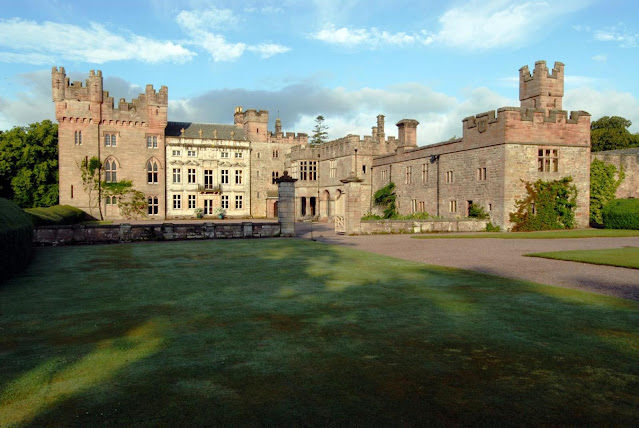Following our recent holiday in Normandy, and exploration of the links between Lassay-les-Chateaux and Lancelot du Lac, I have become interested in the legends connecting King Arthur with Cumbria. I hadn't fully appreciated that there is an awful lot of evidence to place Camelot in Cumbria, that is if we accept that King Arthur and Camelot existed, in some form, at all.
First of all there is the Arthur's Round Table. The Round Table probably moved around, providing a place for Arthur's knights to come together. It would therefore have stood in various locations around the country as and when his parliament of knights needed to gather. But an earthworks at Eamont Bridge, near Penrith has been aptly-named ‘King Arthur’s Round Table’. The site is a natural amphitheatre and would have been ideal. It is also thought that fifty champions of the realm met there to joust for the hand of King Arthur’s daughter, Gwyneth.
 |
| Arthur's Round Table, Eamont Bridge |
Alfred, Lord Tennyson provided more evidence for Arthur in Cumbria when he wrote the final book of The Idylls of the King: The Passing of Arthur. This was written whilst Tennyson was staying at Mirehouse on Bassenthwaite:
Then spake King Arthur to Sir Bedivere:
"Far other is this battle in the west
Whereto we move, than when we strove in youth,
And brake the petty kings, and fought with Rome,
Or thrust the heathen from the Roman wall,
And shook him thro' the north....
The bold Sir Bedivere uplifted him,
And bore him to a chapel nigh the field,
A broken chancel with a broken cross,
That stood on a dark strait of barren land:
On one side lay the Ocean, and on one
Lay a great water, and the moon was full.
The story goes that when King Arthur was on his death bed he asked one of his knights to return the legendary sword, Excalibur to the lake it originally came from, Bassenthwaite. Bedivere, the knight in question fulfilled Arthur’s wishes, after some prevarication, before the King asked to be taken to Avalon.
 |
| Bedivere and Excalibur on Bassenthwaite |
Some versions of the legend say that Arthur didn’t actually die,
only that he went into an extended hibernation. A gathering of Arthur’s
loyal knights are supposed to have taken the fatally wounded king to
Avalon and after returning the sword of Excalibur to Bassenthwaite. The
representation of Avalon is thought to be Blencathra, a mountain only 12
miles from the lake.
Camelot was King Arthur’s base. Although historians are sceptical about the existence of a real King Arthur, it has been suggested that the city of Carlisle would be the place most likely for the king to base his headquarters. Other Cumbrian locations have also been proposed, including along the Solway Firth and a once contested area along the Borders, now known as Longtown.
Not far from Kirkby Stephen lie the ruins of Pendragon Castle. The myths say that it was originally built by Uther Pendragon, the father of King Arthur. Pendragon supposedly tried to divert the waters of the nearby River Eden to form a moat, but neither his engineering nor the magic of the wizard Merlin could persuade the river to alter its course. Uther is said to have died in the castle, when Saxon soldiers poisoned the water in his well. This is clearly all part of the Arthur in Cumbria myth, as the castle was actually built in the Twelfth century by the Normans.
 |
| Pendragon Castle |
By 410AD, the Roman grip on Britain was slipping and many of the Empire’s solders were being withdrawn. The legend of King Arthur claims that a young Arthur trained in a warrior school on the Roman Wall, so it is quite likely that this would have been at one of the forts along Hadrian’s Wall in the north of Cumbria.
At the other end of Arthur’s endeavours, his last battle was at Vamlann, also known as Camboglanna. This is thought to be the old Roman name for Birdoswald. Now the longest surviving stretch of Hadrian’s Wall, Birdoswald could quite possibly be the location of Arthur’s last battle as King.
 |
| Birdoswald Roman Fort |
Other places linked with the Arthur legend are Aira Force waterfall along the shore of Ullswater. Aira Force was home to Sir Eglamore, a noble Knight of the Round Table. He lived near Aira Force with his beloved Emma. There is a love story, immortalised in William Wordsworth’s The Somnabulist, which Emma missed her knight so much as he was away fighting in the Crusades that she could not sleep. One night she was sleep walking by the falls dressed in white. Sir Eglamore thought what he saw was a phantom. When he realised it was Emma, he called out to her but he startled her and she fell to her death. He was so heartbroken he lived out his days as hermit under the falls of Aira Force.
To win this bright Bird from her cage,
To make this Gem their own,
Came Barons bold, with store of gold,
And Knights of high renown;
But one She prized, and only one;
Sir Eglamore was he;
Full happy season, when was known,
Ye Dales and Hills! to yon alone
Their mutual loyalty...
 |
| Aira Force, near Ullswater |
Finally, Hutton-in-the-Forest claims to be the legendary Green Knight’s Castle in the Arthurian tale of Sir Gawain and the Green Knight. Its forest was the second largest Royal Forest in mediaeval England.
 |
| Hutton-in-the-Forest |
We have visited many of these places connected with King Arthur, and plan to explore the remaining locations over coming months.